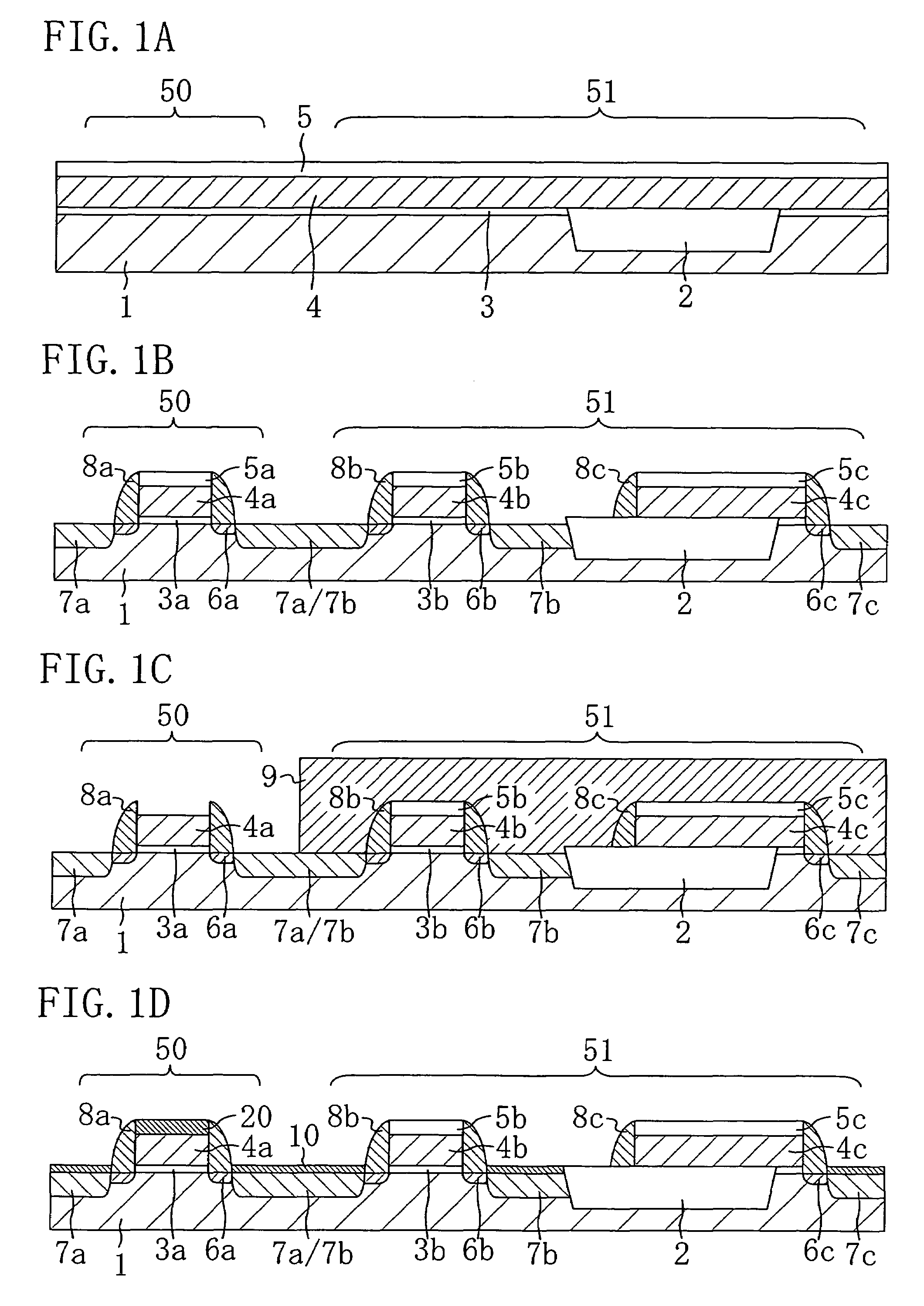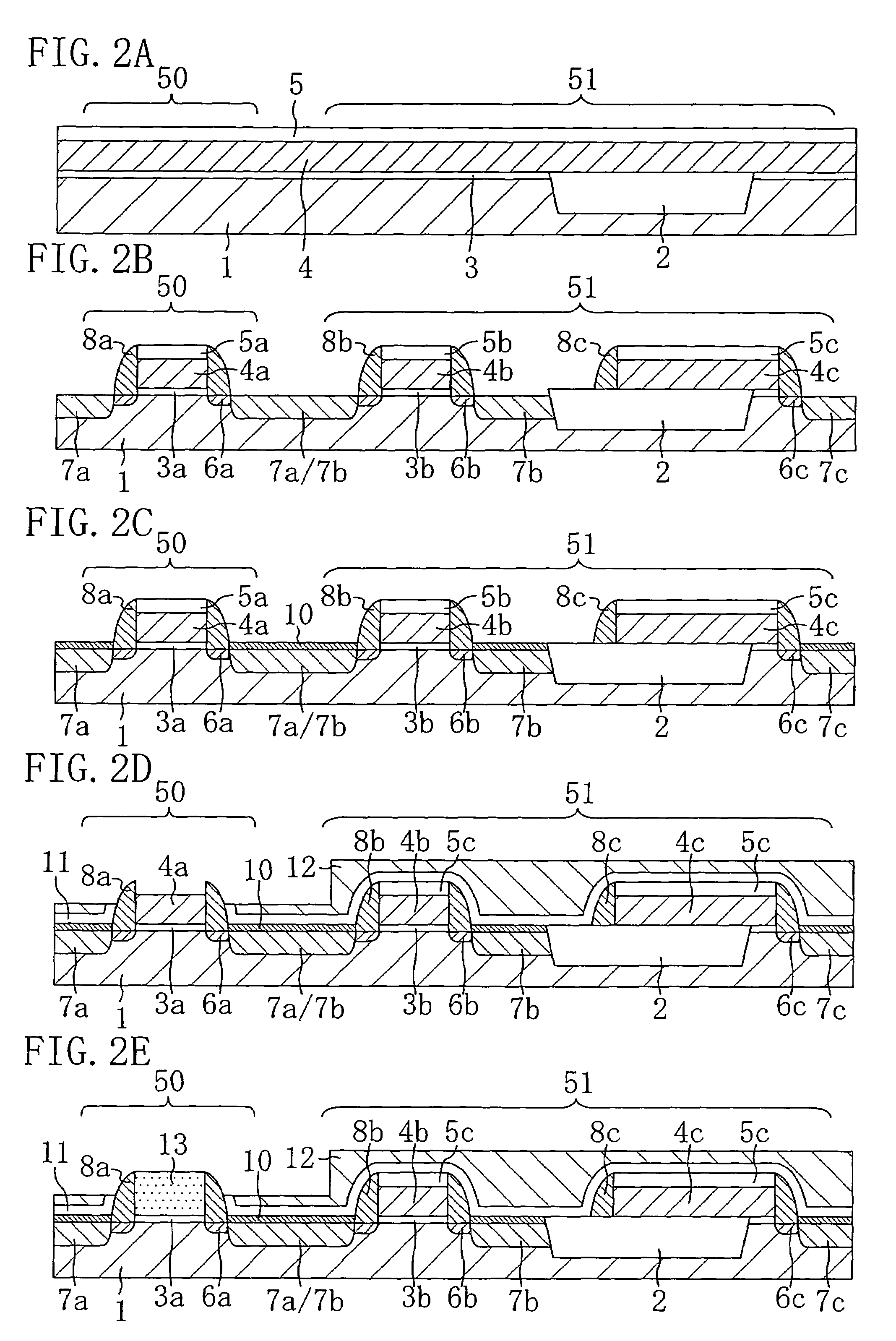Semiconductor device
a technology of semiconductor devices and gate electrodes, applied in semiconductor devices, semiconductor/solid-state device details, electrical apparatus, etc., can solve the problems of difficult control of the amount of siliciding formed by the minute gate electrode, the dimension of the gate electrode and the distance between adjacent ones of the gate electrodes is reduced, and the short circuit between the gate electrode and the dummy gate electrode is prevented, so as to achieve high yield and prevent short circuit
- Summary
- Abstract
- Description
- Claims
- Application Information
AI Technical Summary
Benefits of technology
Problems solved by technology
Method used
Image
Examples
embodiment 1
[0026]A first embodiment of the present invention will be described with reference to the drawings.
[0027]FIGS. 1A through 1D are cross-sectional views illustrating a fabrication method for a semiconductor device according to the first embodiment of the present invention. “Dummy gate electrodes” herein represent gate electrodes of a semiconductor device that are not concerned with circuit operation. As previously described, dummy gate electrodes are formed to finish gate electrodes as designed or to make the top surface of an interlayer dielectric uniform in planarization of the interlayer dielectric. When dummy gate electrodes are formed to finish gate electrodes as designed, they each often have a gate length of 10 μm or less. When dummy gate electrodes are formed to make the thickness of an interlayer dielectric uniform, they each often have a gate length of 10 μm. In this embodiment, a description will be given of a fabrication method for a semiconductor device including a MIS tr...
embodiment 2
[0041]FIGS. 2A through 2E are cross-sectional views illustrating a fabrication method for a semiconductor device according to a second embodiment of the present invention. In these figures, the same components as those of the semiconductor device of the first embodiment are denoted by the same reference numerals, and thus a description of the same components will be simplified.
[0042]First, in the process step illustrated in FIG. 2A, like the process step illustrated in FIG. 1A of the first embodiment, an isolation region 2 is selectively formed in a semiconductor substrate 1. As a result, active regions are formed in the semiconductor substrate 1 so as to be surrounded by the isolation region 2. Subsequently, a 2-nm-thick first insulating film 3 and a 100-nm-thick polysilicon film 4 are deposited on the semiconductor substrate 1. Thereafter, a 20-nm-thick second insulating film 5 is deposited on the top surface of the polysilicon film 4.
[0043]Next, in the process step illustrated in...
embodiment 3
[0055]Another method for selectively siliciding only a gate electrode formed on an element formation region will be described in a third embodiment of the present invention.
[0056]FIGS. 3A through 3E are cross-sectional views illustrating a fabrication method for a semiconductor device according to the third embodiment of the present invention. In these figures, the same components as those of the semiconductor device of each of the first and second embodiments are denoted by the same reference numerals, and thus a description of the same components will be simplified.
[0057]First, in the process step illustrated in FIG. 3A, like the process step illustrated in FIG. 1A of the first embodiment, an isolation region 2 is selectively formed in a semiconductor substrate 1. As a result, active regions are formed in the semiconductor substrate 1 so as to be surrounded by the isolation region 2. Subsequently, for example, a 2-nm-thick first insulating film 3 and a 100-nm-thick polysilicon fil...
PUM
 Login to View More
Login to View More Abstract
Description
Claims
Application Information
 Login to View More
Login to View More - R&D
- Intellectual Property
- Life Sciences
- Materials
- Tech Scout
- Unparalleled Data Quality
- Higher Quality Content
- 60% Fewer Hallucinations
Browse by: Latest US Patents, China's latest patents, Technical Efficacy Thesaurus, Application Domain, Technology Topic, Popular Technical Reports.
© 2025 PatSnap. All rights reserved.Legal|Privacy policy|Modern Slavery Act Transparency Statement|Sitemap|About US| Contact US: help@patsnap.com



